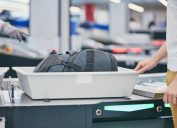9 Foods to Never Bring Through Airport Security, Experts Say
You might hold up the line if you've got these in your carry-on.
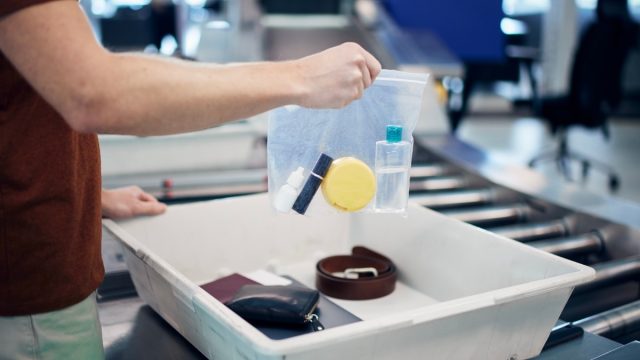
Even if we're not running to catch a flight, the thought of being stopped in the airport security line fills us with dread. Nobody wants to be the one who's holding up the line or who gets pulled aside to have a TSA agent rifle through their carefully-packed carry-on. And you really don't want to surrender your snacks or gift goodies just because you didn't realize your jumbo jar of Nutella was on the no-fly list (though a live lobster is fully allowed to accompany you on board). Keep reading to get the facts from travel experts on what foods you should never bring through airport security.
READ THIS NEXT: Never Do This After Checking a Bag, Flight Attendant Says.
1
Peanut butter
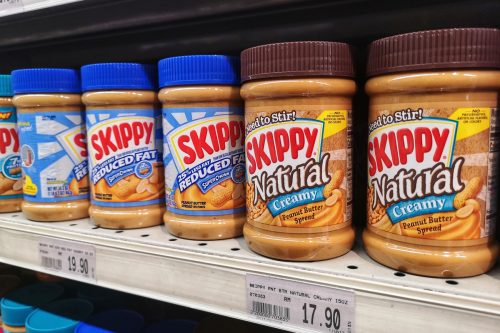
By now you may be familiar with the TSA 3-1-1 rule for liquids in your carry-on bags: You may carry liquids on board if they're in containers of 3.4 ounces or less; they must fit in one quart-sized bag; one bag per passenger. But it's more helpful to know what qualifies as a liquid. Anything creamy or spreadable is also subject to the rule—think Nutella, honey, maple syrup, yogurt, cream cheese, or jam.
"If your take-out food has a lot of hummus, peanut butter, salsa, or yogurt, your bag will likely be flagged. If the food is a dip (salsa, hummus) or spreadable (peanut butter), you shouldn't take it with you through TSA security," says Cheryl Nelson, travel preparedness expert and founder/owner of Prepare With Cher.
One exception to the rule: Baby food, baby formula, or breast milk, all of which may be brought on board in larger sizes. Just inform the TSA agent in advance of the screening process and expect to be screened separately.
2
Soft cheese
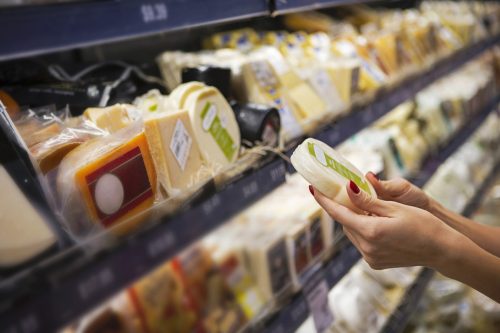
Another food that masquerades as a liquid is soft or creamy cheese. According to the TSA, it's fine in your checked luggage, but if it's going in your carry-on, it'll need to be 3.4 ounces or less. Solid cheese is not a problem.
READ THIS NEXT: 5 Surprising Items Customs May Flag You for at Airport Security.
3
Fresh fruit
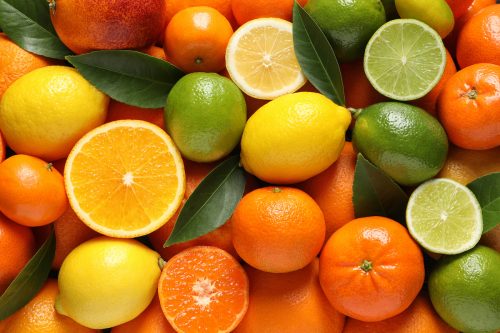
If you're traveling internationally, or to Hawaii, Puerto Rico, or the U.S. Virgin Islands, don't bring fresh produce on board. Nelson explains that fresh fruits and vegetables are prohibited due to agricultural restrictions made to prevent the possibility of transporting pests.
"If traveling internationally, you won't be able to bring in items like oranges unless you declare them at customs when you arrive," says Becca Siegel, co-owner of Half Half Travel. "Even then, some countries are super strict about natural produce products, so you're best leaving them behind or eating them before security so they don't make it onto the plane."
4
Canned goods

Canned sardines, caviar, fruits, and vegetables may cause concern if they're in your carry-on. Even though the contents may not be liquid, and they may be sealed, the containers can obscure the scanning process.
"If you have anything canned, be prepared for your bag to get flagged and checked," notes Heidi Ferguson, a flight attendant with 20 years of experience in the commercial and private aviation industry. "I've seen it happen a lot when people had caviar or sardines or canned snacks as souvenirs and were second screened as the x-ray scanner can't decipher what it is. If you want to avoid that, pack the cans in your checked luggage."
5
Wet pet food

Wet cat and dog food will need to follow the 3-1-1 rule in your carry-on. According to the TSA, "There is no medical exemption for prescription pet food, even for service animals." Dry food is OK.
For more travel advice delivered straight to your inbox, sign up for our daily newsletter.
6
Thawed ice packs.

Anything frozen makes the cut, as long as it's actually frozen solid. Melted ice or frozen foods–or thawed ice packs–likely won't slide by. According to TSA guidelines, meat, seafood, vegetables, and other non-liquid food items are permitted in carry-on bags, but if they're packed with ice or ice packs in a cooler, for example, the ice must be completely frozen when they arrive for screening.
7
Alcohol that's more than 140 proof.

If you're bringing booze on board, make sure it's not over 140 proof/70 percent ABV. Forbidden spirits include 151-proof rum and grain alcohol. If the alcohol is less than 70 percent ABV, you can stash up to five liters in your checked luggage (there are no limits for 24 percent or less) as long as it's in unopened retail packaging.
To bring on board, mini bottles of alcohol should follow the 3-1-1 rule and fit in a single quart-sized bag. And, of course, FAA rules prohibit drinking alcohol on board if it's not served by a flight attendant.
8
Jam or spreads
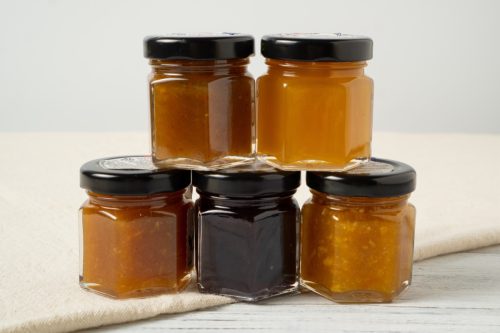
They may not seem so, but condiments like jam or spreads are actually considered liquids.
"Even mini jars aren't technically solids, and they'll still stop you if they're shrink wrapped and sealed," Taylor Beal, owner and author of the travel blog Traverse With Taylor, told Best Life. "If you're traveling in an area known for their delicious spreads (like the fantastic mustard in Ghent, Belgium!), make sure it is placed into your checked luggage."
9
Baby Food
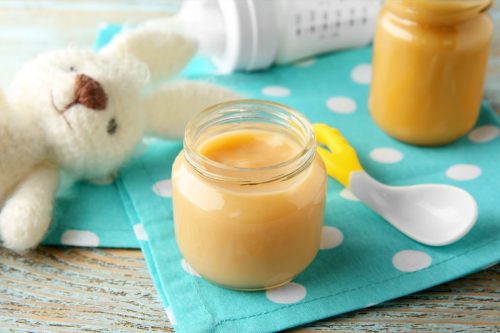
Of course, if you have a baby, no one is going to stop you from feeding them on the plane. So, TSA does give the green light on baby food, but only if it's in "reasonable quantities."
It's a little tricky because the amount you can bring is unclear (it really depends on each individual TSA agent), but it's definitely something to keep in mind since it can cause a delay at security. "I was recently asked to throw out some baby food (that was sealed), because it was deemed an excessive amount," says Beal.
She recommends only taking the amount you think your baby will need on the plane and checking or getting rid of the rest pre-security.

